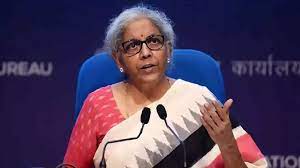Sitharaman, who was speaking at the Mindmine Summit, drew a direct contrast between foreign investors, who she argued were confident about investing in India, and the domestic private sector, which appears to be hesitant.
Centre has been pushing for investments, but private sectors seems hesitant to take the plunge
By: Editorial
September 15, 2022 4:05:20 am
A few weeks after government data showed that the Indian economy was growing at a slower pace than expected, Finance Minister Nirmala Sitharaman exhorted the private sector to step up investments in the country. Sitharaman, who was speaking at the Mindmine Summit, drew a direct contrast between foreign investors, who she argued were confident about investing in India, and the domestic private sector, which appears to be hesitant. “Since 2019 when I took charge of the finance ministry, I have been hearing industry doesn’t think it (environment) is conducive… I want to hear from India Inc. what’s stopping you?” she said. The minister listed various steps that the government has taken over the years to encourage investment activity in the economy — from cuts in the corporate tax rate to production linked incentive schemes. Yet, despite these, there isn’t concrete evidence of a broad-based pick up in investments.
Investment activity has remained muted since 2015-16, with the share of gross fixed capital formation, which connotes investments in the economy, hovering around 28 per cent of GDP. While activity did bounce back from the depths of the pandemic, at the end of 2021-22, investments were only 3.7 per cent higher than their pre-pandemic levels of 2019-20. And there aren’t enough indications of a significant uptick in investments in the near term. As per CMIE, in the first quarter of this year, investment proposals for adding new capacities in industrial, infrastructure and services, added up to Rs 3.57 lakh crore. This is only marginally higher than the average investment proposals in the preceding three quarters.
In the past, the twin balance sheet problem — an over-leveraged corporate sector and banks saddled with bad loans — was thought to have been holding back investment activity. Since then corporate and bank balance sheets have improved, but large parts of the economy continue to struggle. As per a report in this newspaper, 16.4 per cent of the loans availed by MSME under the ECLGS facility during the pandemic have turned bad as borrowers are not able to service the loans due to financial distress. Among the informal units, with no access to formal sources of finance through which government support was made available, the stress is likely to have been even more severe. Considering that the MSMEs account for a sizeable share of employment, this impacts both employment and income prospects. The clearest sign of the persisting labour market distress comes from the continuing reliance on MGNREGA. This uncertainty over job and income prospects reflects in consumer sentiments remaining in the pessimistic zone, which in turn affects business sentiment and investment decisions.
© The Indian Express (P) Ltd
